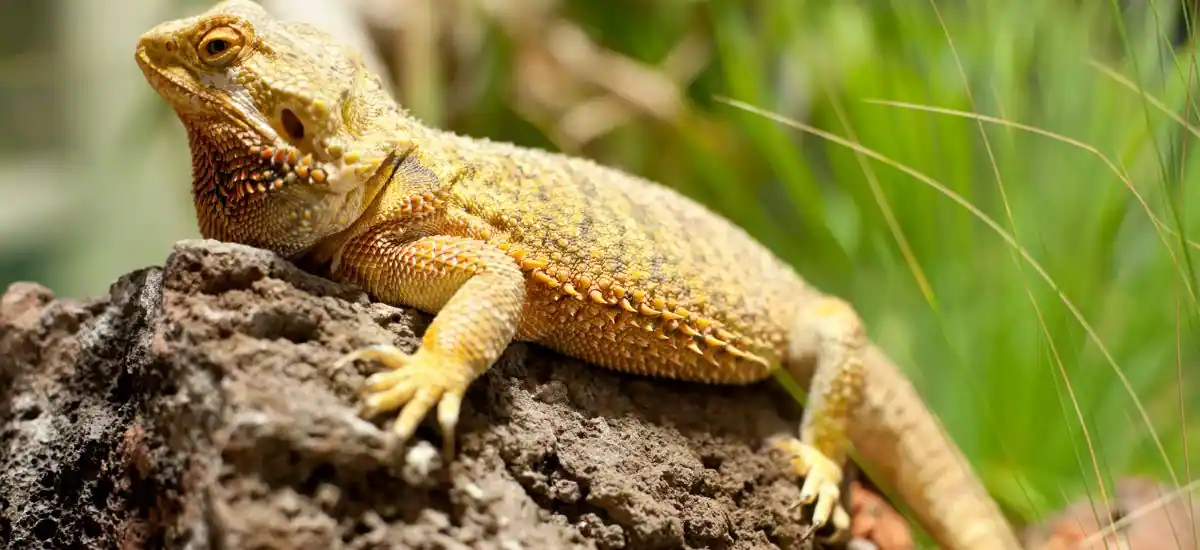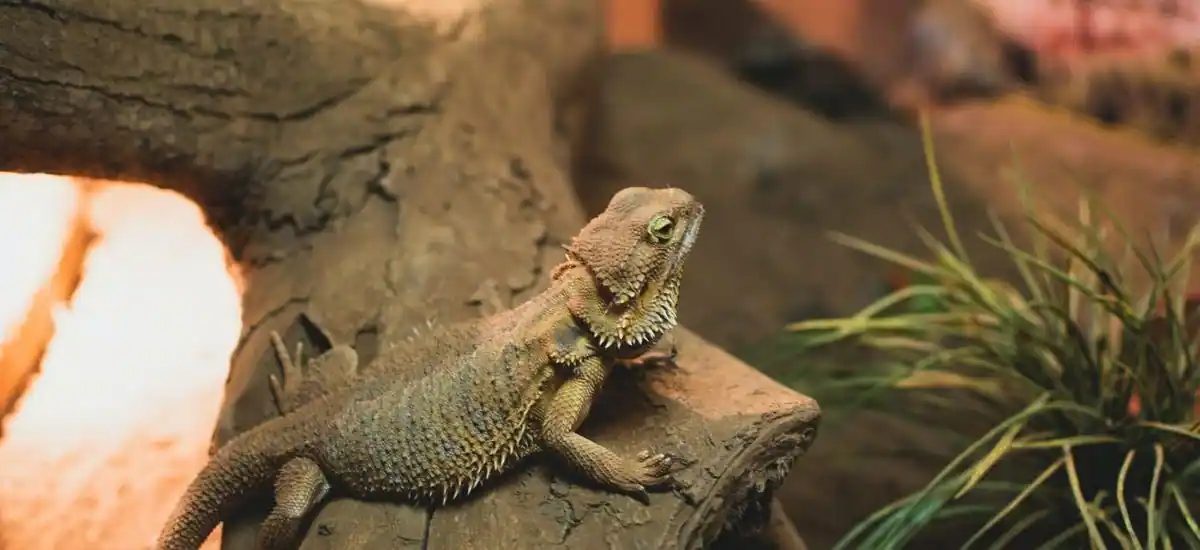Being a parent of a beardie requires a lot of responsibility. You have to make sure your baby pet is well taken care of and meets their health and unique terrarium needs. Isn’t it great to have a great understanding of various kinds of diseases your dragon can catch and preventative measures to keep them at bay?
Also, isn’t it a good thing to know when your big-tailed reptile needs a vet’s attention?
Among various illnesses, Yellow Fungus is the most common illness that a beardie can catch in the blink of an eye.
What is Bearded Dragon’s Yellow Fungus?

Want to know what exactly is Yellow Fungus?
Then let’s first talk about what this awful infection is..!
Whether there is a cure or not remains a hot debatable topic on the internet.
Some beardie parents will tell you that there is no cure, while some will say that if you catch it in the early stages then, it can be treated.
So that being said, your best bet is to give a healthy life to your baby pet by knowing the symptoms ahead of time.
If you don’t have a good understanding, then we are here to give you important details like its treatment, prevention, care, and so on to give your beardie for the long run.
Today, we will be talking about the signs, symptoms, causes, treatments, and preventative measures of Yellow Fungus.
Many new reptile owners usually ask, “Is the yellow skin of a bearded dragon a disease?
Yes, Yellow Fungus or Chrysosporium Anamorph of Nanniziopsis visit (CANV) is a contagious disease that can infect reptiles and affect their tissues at deeper levels.
If not treated in time, it can reach their internal organs.
Recognize The Signs
Let’s check out some common signs and symptoms of yellow fungus in a bearded dragon in the chart below:
| No | Symptoms and signs |
|---|---|
| 1. | Yellow, brown, black, or gray patches on scales which spread over time |
| 2. | Discolored areas may have cracked/crusty/fuzzy textures. |
| 3. | Frequent shedding, revealing rough scales underneath |
| 4. | Weight loss |
| 5. | Poor appetite |
| 6. | Sunken eyes |
| 7. | Slow wound healing |
| 8. | Sloughed lesions which are swollen badly, exposing ulcerated wounds |
| 9. | Dead body parts which eventually break or fall off |
| 10 | Restless behavior |
| 11. | Wounds that do not heal in a reasonable time frame |
So these were some signs and symptoms to look out for in your dragons.
The wounds usually begin with a small spot, and as time goes by, they grow big, and you will notice several spots in other parts of their skin. You must take each of these signs very seriously and rush to your nearby vet clinic.
In the next section, we will talk about how bearded dragons get Yellow Fungus.
Know About: Is It Okay For Bearded Dragons To Open Mouths Often?
Main Causes Of Contracting Yellow Fungus
You won’t notice the signs even after several weeks and months pass, making it tricky to identify the root cause of the infection.
And it becomes trickier if the pet is hugely cared for or the owner has got a new beardie.
Below, you can check out the most common causes of Yellow Fungus in the bearded dragon:
1. Poor hygiene
2. Depressed immune response related to low temps
3. Prescribed antibiotics
4. Poor nutrition
5. Cohabitation
6. Direct or indirect contact with an infected reptile
7. Poor Husbandry Conditions such as:
- Improper UVB exposure
- In low temperatures
8. Encounteiring YF Pathogen Exposure through:
- Being amongst infected dragons
- Give your dragon to a person who has handled an infected reptile previously.
- You are not washing the tank accessories and putting them back around an infected beardie’s habitat.
Did you sense a pattern here?
If you did, then these are the clear red signs!
Generally, your baby pet will come in contact with the YF pathogen if they touch someone/something or are touched, which has also been connected by an infected dragon.
It makes sense, right?
So these were some most common ways a healthy dragon can encounter YF.
If you notice any similar cause, move towards the next section of this read to find out how to treat Yellow fungi in a bearded dragon.
Treatment Of Yellow Fungus In A Bearded Dragon

If you suspect your cute reptile pet has Yellow Fungus, then you need to act fast, mate!
1. Isolate your beardie
If you own more than one bearded dragon, then isolate all of them and watch them closely for signs of disease. You are reducing the risk of cross-infection from an infected beardie to a healthy one by doing so.
If any of your beardies are infected, keep them in a separate cage and discuss with your vet to prevent transmission.
We know that you feel bad for isolating your beardie from his mates, but that is the only thing you can do to keep him and his friends safe.
2. Quarantine Your Buddy
As we discussed above, you should keep your beardie away from your other reptile pets. Keeping them under quarantine does not mean you should keep them caged without any habitat.
You can give them new toys to play with, new food vessels, and a fresh habitat to stay in to make them feel happier while healing.
3. Proper Hygiene and Sanitation
Sanitization and proper hygiene are a must!
If you follow this rule, trust us, you will reduce the risk of the pathogen spreading to other parts of your pet’s body.
And one more thing!
Suppose your reptile mate is adequately fed and is given excellent husbandry (hiding spots, the right amount of humidity, appropriate lighting, thermal gradient). In that case, there are chances of your pet resisting an infection.
- NOTE: Avoid getting a reptile stored in a crowded environment, has skin lesions, or shares the same container with other reptiles with skin lesions.
4. Prognosis and Outcome
Yellow Fungus has long-term treatment or is fatal for those who don’t get their reptile pets treated early.
We don’t want to scare you, but the chances of curing your beardie will be successful if it is diagnosed and treated by the best vet.
5. Zoonotic Potential
Many beardie owners ask a common question to their vets, “Is Yellow Fungus Contagious to Humans?“
No, it is not!
Yellow Fungus poses little to no threat to us. Want to know why?
It is primarily a reptile pathogen, so the chances of this pathogen are only high among reptiles and not humans.
But wait!
That does not mean you should take this disease lightly.
We advise you to wash your hands after you handle your pet, disinfect the surface that comes in contact with them, wash your clothes in hot water, and use separate utensils for them.
If you are still unsure what to do, then call your doctor for assistance.
6. Debridement
Am I hearing this word for the first time?
Well, debridement is a process to clean and remove the Yellow Fungus that some antifungal medications are unable to remove from your pet’s skin.
If things go out of your hands, give them oral medications because the pathogens can usually go deeper than just the skin.
7. Visit your vet as soon as possible!
Want you to know if Yellow Fungus infects your beardie or not?
Then, take them to the vet!
Once you are there, the vet will run some tests on your pet to confirm if Yellow Fungus or another fungus infects your beardie.
If the tests are positive, you can expect the doctor to suggest various treatments like antifungals, drugs, or ointments, or choose both the combination of the medication.
If you can’t take your pet to the doctor right away, then in the meantime, you can read and try some of our safe home-based treatments below.
Home Remedies For Yellow Fungus In Bearded Dragons
Can’t make an appointment right away with the vet or don’t have enough cash to head to the reputed vet?
Well, we have got you covered!
While you wait to see the vet, you can try our home remedies to keep your beardies in check:
1. Arrange Betadine Baths for bearded dragons
Betadine won’t fight the Yellow Fungus, but it will remove the shedding fungus and keep your reptile pet squeaky clean. However, avoid giving frequent baths, which will help the pathogens to spread faster.
You must be thinking, then what is the best way?
You can give them a Bethadine bath once a week, just for five to 10 minutes or so.
Once done, dry your beardie with a clean and dry towel because it will help the pathogens spread more.
- NOTE: To every gallon of water, mix ¾ cup of betadine.
2. Lamisil
Many reptile owners ask the vets, “Can I Use an Antifungal Cream for My Bearded Dragon?” or “Can I use Lamisil for my reptile pet?”
Yes, you can!
This antifungal cream is mainly used for scaling, cracking, burning, and itching.
Sources reveal that many reptile parents have given positive reviews about Lamisil and have shared that it gives excellent results.
Some have also claimed that Lamisil and Bethadine baths alone have cured Yellow Fungus in their reptile pets, while some did not notice any difference.
The effectiveness of these treatments likely depends on what stage your pet is or how affected their skin is!
All you have to do is dry your pet first and apply it twice a day in the infected scaly area. And toss the towel into the laundry, of course!
3. Raw Unpasteurized Honey
Raw and unfiltered honey can do wonders on your beardie’s body.
Yes, this sounds a little weird, but honey is an excellent weapon against fungal infections and heals wounds.
- NOTE: Finding difficulty in keeping the honey on your tiny beardie? Then, try applying it and wrapping a breathable cloth or gauze around your pet and let your beardie soak in the benefits on their skin for few hours.
Other medications to use under vet prescriptions
Suppose the situation still doesn’t work in your favor. In that case, you can use itraconazole, terbinafine, amphotericin B, or voriconazole on your pet’s lesions or skin biopsy sites as per the vet’s recommendations.
Yellow Fungus Bearded Dragon Prevention Measures

Here, you will find some steps to help your reptile pet from contracting Yellow Fungus.
So do check out the preventative measures you must take right now:
Prevention Measure #1: Practice Good Husbandry
As aforementioned, get into a good habit of cleaning your reptile pet’s habitat regularly.
Wash all the accessories with a cleaner and disinfect them, spray the disinfectant on the walls, or wash it with a cleanser and disinfect or replace the substrate.
In addition to this, make sure the tank and the right amount of temperatures and your pet receive UVB rays.
Prevention Measure #2: Keep Your Dragon Clean
Your job is not done yet!
You have to bathe your beardie with gentle baby soap and warm water once a week, lasting no more than fifteen minutes.
Many people will tell you that it is pointless so don’t listen to them!
Prevention Measure #3: Separate Your Bearded Dragons
Don’t you forget something?
Yes, you are!
And that is keeping your two or more in separate tanks.
The yellow fungus is impossible to detect, so keep your reptiles separate. There are many other reasons you should do so, and they are mentioned below:
- Males will fight with each other and pester the females about mating.
- It can be fatal for the dragons.
- If beardies get along together when they are babies does not mean they will live happily after becoming adults.
- Dragons are solitary and are meant to live alone in deserts.
So all the stories of putting all the beardies under one roof are not valid. If you can’t afford it, make a separate habitat or get one reptile pet only!
Prevention Measure #4: If possible, Disinfect Any New Toys, Tank Accessories, or Your Tank ASAP!
A Clean Terrarium will not only keep your reptile happy but also free from various diseases!
Many pet parents have reported that their beardies got Yellow Fungus after introducing new accessories to their terrariums like rocks and hammocks.
Retailers are irresponsible, but you are not!
Thus, it is wise to wash the new toy or accessory before installing it into the habitat or giving it right away.
It’s better to be safe than sorry!
I am wondering what else you Can Do to keep your bearded dragon safe from Yellow Fungus.
Then read on!
Other Ways To Protect Your Bearded Dragons From Yellow Fungus
1. Start your Dragon on Probiotics
Giving them probiotics will help them to fight against any disease. You can also give them royal jelly or bee pollen to build their immune system.
2. Let them bask in the direct sunlight
Just like us, beardies love to soak up the sun as well. So please place them in a room full of sunlight and let it strengthen their immune system.
3. The correct diet
The right is the secret ingredient to your dragon’s life!
When your beardie is battling with severe disease, he needs all sorts of nutrition to survive. Give them staple food, cut down on all the occasional items, or give particular food as per your vet’s advice.
You can check out the food chart below:
| Staple Greens | Staple Vegetables | Staple Fruits |
|---|---|---|
| Dandelion Green | Acorn Squash | Cactus Leaves (Prickly Pear) |
| Endive | Butternut Squash | Mango |
| Mustard greens | Green Beans | Papaya |
| Turnip greens | Kabocha Squash | |
| Chicory Greens (Escarole) | Okra | |
| Collard greens | Parsnip | |
| Watercress | Snap Peas | |
| Sweet Potato | ||
| Yucca Root (Cassava) |
4. Avoid stress
Is your dragon stressed out lately?
Then keep them calm and try to place their habitat in a noise-free and stress-free environment and away from other animals.
5. Regular vet checkups should be your priority
Make sure to visit your vet if they are coping and thrive with any illness.
6. Give tons of attention and love to your bearded dragons
Last but not least, give affection and care because that’s what your beardie needs! A sick or unloved reptile will feel stressed all the time, so why not love them?
After all, there is nothing better than the comfort Beardie’s parents give to make them feel better.
If they feel better, then they will heal faster!
Conclusion
If you take action quickly, then Yellow Fungus won’t be a death threat! Also, if you care for your pet’s life and want him to live longer, then seeking the vet’s assistance is the only way!
Practicing what we have written above will surely make a difference and save your precious pet’s life. And remember! Don’t give the mentioned medications or treatments without asking your vet.
As the saying goes by, “Prevention is better than cure!” So follow the above treatments, and preventative measures, and maintain a clean and healthy environment for your beardie or other reptile pet.
We wish good health to you and your baby reptile pet!
Read More: Can Bearded Dragon Eat Grapes ? Are They Good For Them


Leave a Reply
You must be logged in to post a comment.